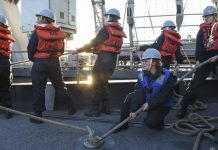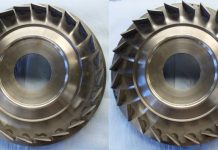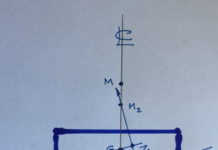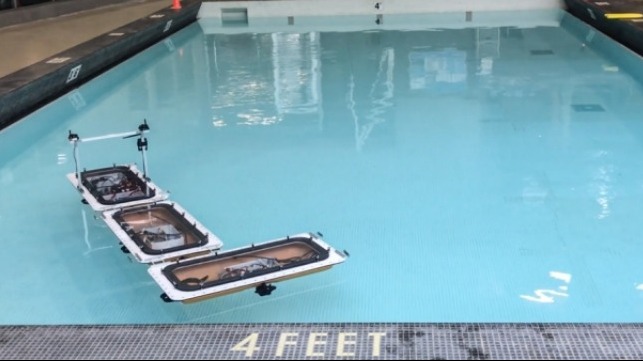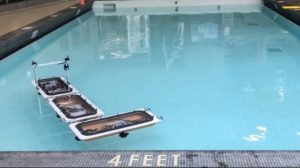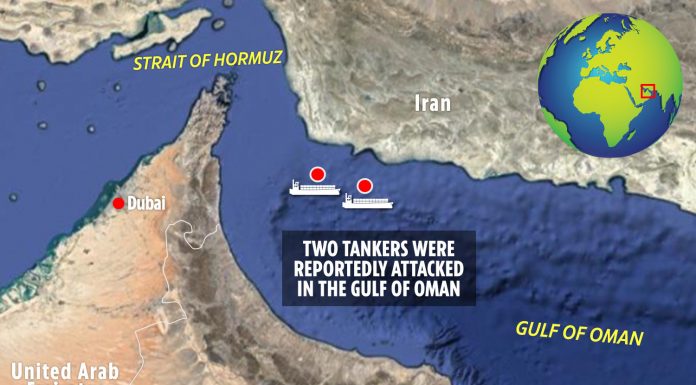Researchers from Massachusetts Institute of Technology (MIT) have formed a fleet of robotic boats that can autonomously detach, attach and assemble itself into a variety of configurations.
The autonomous boats – rectangular hulls outfitted with sensors, thrusters, micro-controllers, GPS modules and cameras – are being developed as part of the current “Roboat” project between MIT and the Amsterdam Institute for Advanced Metropolitan Solutions (AMS Institute).
Amsterdam wants the “roboats” to sail its 165 winding canals, transporting goods and people, collecting trash, or self-assembling into pop-up platforms, such as bridges and stages. This will help and relieve the congestion on the city’s busy streets.
In the year 2016, MIT researchers tested a roboat prototype that could only move forward, backward and laterally along a pre-programmed path in the canals. With the advent of the technology last year, researchers designed low-cost, 3-D-printed, one-quarter scale versions of the boats, which were more capable and agile. It came equipped with leading trajectory-tracking algorithms. In June, they formed an autonomous latching mechanism that let the boats target and clasp onto each other, and keep trying if at all they fail.
The researchers have developed an algorithm that empowers the roboats to smoothly reshape themselves as accurately as possible. The algorithm handles all the planning and tracking that enables groups of roboat units to unlatch from one another in one set configuration, sail a collision-free path, and reattach to their required spot on the new set configuration.
In demonstrations in an MIT pool and in computer simulations, groups of linked roboat units reorganize themselves from straight lines or squares into other configurations, such as rectangles and “L” shapes. The experimental transformations only took a matter of few minutes.
To enable flowing operations, the researchers developed two types of units: coordinators and workers. One or more workers connect to one coordinator to form a single entity, called a “connected-vessel platform” (CVP). All the coordinator and worker units have four propellers, a wireless-enabled micro controller, various automated latching mechanisms and sensing systems that allows them to link together.
Coordinators, however, also come outfitted with GPS for navigation, and an inertial measurement unit (IMU), which computes localization, pose and velocity. Workers only have actuators that help the CVP steer along a path. Each coordinator is aware of and can wirelessly communicate with all connected workers. Structures comprise multiple CVPs, and individual CVPs can latch onto one another to form a larger entity.
During shapeshifting, all connected CVPs in a structure compare the geometric differences between its initial shape and new shape. Then, each CVP determines if it stays in the same spot and if it needs to move. Each moving CVP is then assigned a time to disassemble and a new position in the new shape.
Each CVP uses a custom trajectory-planning technique to compute a way to reach its target position without interruption, while optimizing the route for speed. To do so, each CVP precomputes all collision-free regions around the moving CVP as it rotates and moves away from a stationary one.
After precomputing those collision-free regions, the CVP then finds the shortest trajectory to its final destination, which still keeps it from hitting the stationary unit. Notably, optimization techniques are used to make the whole trajectory-planning process very efficient, with the precomputation taking little more than 100 milliseconds to find and refine safe paths. Using data from the GPS and IMU, the coordinator then estimates its pose and velocity at its center of mass, and wirelessly controls all the propellers of each unit and moves into the target location.
Experiments were conducted on quarter-sized roboat units, which measure about one meter long and half a meter wide. But the researchers believe their trajectory-planning algorithm will scale well in controlling full-sized units, which will measure about four meters long and two meters wide.
The researchers hope to use the roboats to form into a dynamic “bridge” across a 60-meter canal between the NEMO Science Museum in Amsterdam’s city center and an area that’s under development. Called RoundAround, the idea is to employ roboats to sail in a continuous circle across the canal, picking up and dropping off passengers at docks and stopping or rerouting when they detect anything in the way. Currently, walking around that waterway takes about 10 minutes, but the bridge can cut that time to around two minutes. This is still an explorative concept.
The project is led by MIT professors Carlo Ratti, Daniela Rus, Dennis Frenchman and Andrew Whittle. “This will be the world’s first bridge comprised of a fleet of autonomous boats,” Ratti says. “A regular bridge would be super expensive, because you have boats going through, so you’d need to have a mechanical bridge that opens up or a very high bridge. But we can connect two sides of the canal by using autonomous boats that become dynamic, responsive architecture that float on the water.”
To reach that goal, the researchers are further developing the roboats to ensure they can safely hold people, and are robust to all weather conditions, such as heavy rain. They’re also making sure the roboats can effectively connect to the sides of the canals, which can vary greatly in structure and design.






